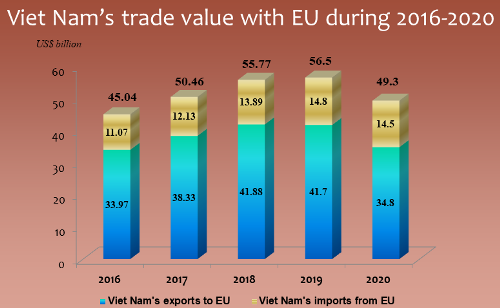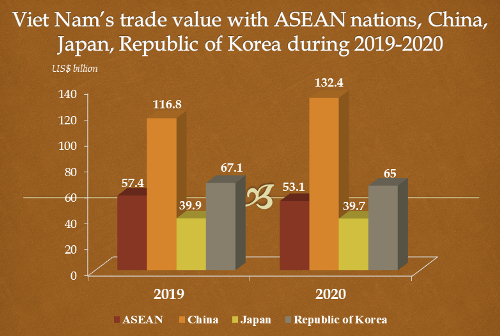FTAs expected to push VN into becoming more competitive
VGP - New free trade agreements (FTAs), which were signed and took effect in 2020, are expected to push Viet Nam into becoming more competitive by reducing trading costs and improving its business environment.
In 2020, Viet Nam’s exports to the EU decrease 2.7% against the previous year while imports from the EU pick up 3.5%, according to the General Statistics Office.
EVFTA comes into effect since August 1, 2020

The European Union-Viet Nam Free Trade Agreement (EVFTA) took effect on August 1, paving the way for increased trade between the EU and Viet Nam.
The EVFTA is an ambitious pact providing almost 99% of the elimination of custom duties between the EU and Viet Nam.
According to the Vietnamese Ministry of Planning and Investment (MPI), the FTA is expected to help increase Viet Nam’s GDP by 4.6% and its exports to the EU by 42.7% by 2025.
While the European Commission has forecasted the EU’s GDP will increase by US$29.5 billion by 2035.
Viet Nam’s National Assembly on June 8, 2020 ratified the EVFTA and the EU-Viet Nam Investment Protection Agreement (EVIPA) following almost 10 years of negotiations.
65% of duties on EU exports to Viet Nam will be eliminated while the remaining will be gradually phased out over a period of 10 years. 71% of duties will be eliminated on Viet Nam exports to the EU, with the remaining being eliminated over a period of seven years.
RCEP inked, creating world’s largest free trade area
 |
|
Nine ASEAN member countries, China, Japan and Republic of Korea-12 members of RCEP- are among largest trade partners of Viet Nam. |
The trade pact involves 10 ASEAN member nations - Brunei, Cambodia, Indonesia, Laos, Malaysia, Myanmar, the Philippines, Singapore, Thailand, and Viet Nam, and the bloc’s partners - Australia, China, Japan, the Republic of Korea (RoK) and New Zealand.
Together, they account for around 30% of the globe's gross domestic product (GDP) and 30% of the world's population.
The agreement is expected to create the world’s largest free trade area and numerous new supply chains, and make significant contributions to regional economic recovery post COVID-19.
Soon after RCEP takes effect, members will begin to honor their commitments on tariffs. Viet Nam and its partners will remove tariffs on at least 64% of tariff lines.
After 15 to 20 years, Viet Nam will have removed 89.6% of tariff lines for partner countries which, in return, will have removed up to 92% of tariff lines for Viet Nam. Other ASEAN members will remove 85.9% of all tariffs for Viet Nam.
Telecommunications, information technology, machineries, spare parts, chemicals, and agricultural products will immediately benefit from the deal.
Aquatic products will be one of the sectors that can compete in the markets of RCEP partners.
The commitments by China, Japan, New Zealand, Australia, and other ASEAN countries to reduce tariffs to 0% as soon as the agreement takes effect will open up new opportunities for Viet Nam to increase export to RCEP markets.
UKVFTA signed, becomes effective from 23:00 on December 31
 |
|
Due to Covid-19 impacts, two-way trade value between Viet Nam-UK goes down 15% in the first 10 months of 2020. |
Earlier on December 11, Minister of Industry and Trade Tran Tuan Anh and UK Secretary of State for International Trade Elizabeth Truss signed the agreed minutes on the conclusion of negotiations over the UKVFTA.
The UKVFTA was negotiated based on principles that were inherited from commitments in the EU-Viet Nam Free Trade Agreement (EVFTA) and were amended in accordance with the bilateral trade framework between Viet Nam and the UK.
Thanks to the UKVFTA, interests in the bilateral trade ties within the EVFTA will be maintained. The agreement begins a new period in the two nations’ relationship, particularly in key trade sectors.
At the end of the tariff elimination roadmap, 99% of tariffs on goods traded between Viet Nam and the UK will be cut.
This means that Viet Nam will save about £114 million on exports to the UK, while the figure for the UK will be £36 million.
Trade of goods like garments and textiles, leather and footwear, and seafood will see no interruption, with commercial services like those in finance and e-commerce growing further.
Up to now, Viet Nam has signed and negotiated 17 bilateral and multi-lateral free trade agreements, 14 of which have come into force.
By Thuy Dung

